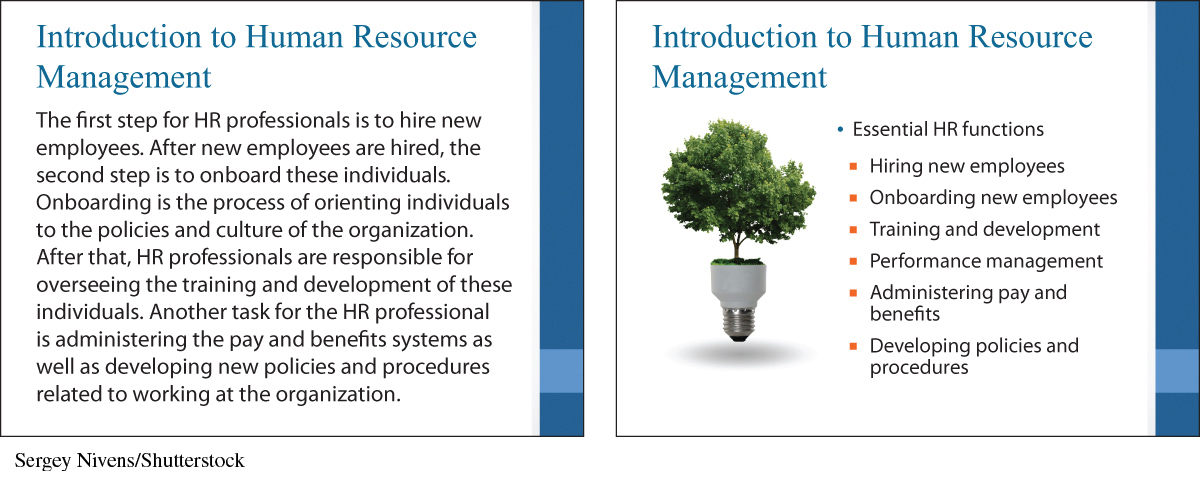Present in Class with Confidence
Speaking in front of a group — for a solo class presentation, for example, or as part of a team project — is a skill that colleges consider part of a well-rounded education and that employers value.3 Just as writing a paper does, authoring and delivering a speech demonstrates your understanding of course content and also shows off your critical thinking skills: To speak intelligently about a topic, you have to gather information about it, evaluate that information, use it in your presentation, and then afterward review the outcomes of your talk — all key components of critical thinking.
243
As valuable a skill as public speaking is, however, for many people it’s utterly terrifying. What can you do if the thought of standing in front of the class gives you stomach butterflies and sweaty palms? You can practice and build your skills to increase your confidence. It won’t happen overnight, but any student can become a successful public speaker.
ACTIVITY: Have students learn about speaking in class by speaking in class. Divide the class into groups and assign each group one of the topics in this chapter. Have each group teach the concept back to the class. If you have access to computers, you can invite students to create lecture slides covering their assigned topic.
Know Your Purpose — and Your Audience
To begin, give yourself plenty of time to plan your presentation. Use that time to figure out the purpose of the presentation and the major points you want to make. For example, if you have to demonstrate a medical procedure in your nursing class, you may design your presentation to inform your audience about how to perform the procedure. If you’re going to show a new smartphone application you developed in your mobile computing class, your purpose may be to persuade classmates that the app is worthwhile. You might even perform a one-act play to entertain classmates in your drama course.
To plan your presentation properly, you also need to consider your audience. Ask yourself:
How many people will be there? If you’re presenting to a small group (fewer than thirty people), you can move around the room and involve your audience. You can pose questions, have listeners complete tasks and report back to the larger group, or even stimulate discussion among audience members. With larger groups, this interactive style is more difficult, so you may decide to spend your time addressing the audience as a whole.
How much do they know about your topic? If your topic is new to the audience, share what you’ve learned while researching your presentation. If your topic is covered in the textbook, your listeners probably know the basics, so use your presentation to provide new information or discuss the topic in more depth.
How can you capture the audience’s interest? Brainstorm ideas for grabbing your audience’s attention at the start of your presentation — for example, by developing a funny (and tasteful) anecdote or joke, a personal story, or an example that will engage the audience while also setting the stage for your topic.

Craft Your Presentation
Many of the same strategies you use to write papers can also help you create presentations. Like written work, most presentations have a thesis statement, an intriguing introduction, a well-structured multipart argument, and a clear conclusion. As with papers, you’ll develop several drafts of your presentation as you work to create the finished product.
Presentations usually use more visual aids than written pieces do, so consider what types of visuals will strengthen your message. You can use slides containing text and images (PowerPoint and Prezi are popular slide-creation tools) or physical objects that demonstrate a process (such as taking blood pressure) or clarify a key concept (such as how electrons move during a chemical reaction). As you weigh your options, pay attention to the visuals your instructors use in class, and consider your own preferences. What types of visuals capture your attention the most? Whatever visuals you decide to include, keep in mind that such aids work best when they convey main ideas and aren’t overly complex (see Figure 10.4).

FOR DISCUSSION: Ask students for examples of engaging speeches or lectures they’ve heard in the past. How did the speeches begin? What grabbed their attention? If students themselves have spoken publicly in the past, how did they get their audience’s attention?
244
Practice Your Presentation

Fear of speaking in public is very common,4 and practicing your presentation is the best way to become more comfortable, confident, and calm. Once you’ve crafted your presentation, rehearse it several times to polish the following elements of your talk:
Time. Work to stay within the time limit. If you have twenty minutes to speak, for example, try keeping your talk between fifteen and seventeen minutes as you practice. That way, you’ll know that your presentation isn’t too short or too long, and you’ll have a few minutes left for questions from your audience.
Voice volume. Make sure you’re speaking loudly enough. If you’ll be using a microphone to give your presentation, practice talking at the same volume you’d use when sitting next to another person. If you won’t have a microphone, practice speaking loudly enough so that people at the back of the room can hear you. And vary the volume and pace of your voice to keep everyone energized — speaking in a monotone is a surefire way to put your audience to sleep.
Body language. Practice showing confidence and authority through your posture and other body language. Stand up straight, make eye contact, and imagine conversing with your audience — glancing only briefly at your notes or slides if needed. Also practice using hand gestures to emphasize points, and avoid nervous gestures that will distract your audience (like tugging at your hair or wringing your hands).
245
To practice your presentation, consider asking trusted friends, colleagues, or classmates to watch you. They can provide feedback on how you can improve. Or record your practice sessions on your smartphone or computer and critique your own performance. It may be hard to hear critical feedback or watch yourself on video, but these techniques will help you strengthen your presentation — and boost your confidence.
Deliver a Great Presentation
When the big day arrives, you can do several things to present successfully.
Look the part. Even if your appearance isn’t factored into your official grade for the presentation, your instructor and audience will notice what you’re wearing. So, approach class presentations as you would a job interview. Ditch the shorts and flip-flops in favor of business casual or nicer clothes. Professional apparel gives you an air of credibility and conveys to your audience that you take the assignment seriously.
Arrive early. By arriving early, you’ll have time to get set up and organize your presentation, notes, and any materials you plan to use.
Breathe and visualize. Take deep breaths and visualize yourself being successful. Settling your nerves in advance will help you deliver a smooth presentation.
ACTIVITY: If you’ve assigned class presentations, divide the class into small groups and have them practice presenting to their group members. Group members can then provide constructive feedback prior to the formal presentation. Have students write up what feedback they received and what they learned from the experience.
Harness the Power of Technology: Present Online
Increasingly, online classes require students to prepare presentations and deliver them using technology tools such as videoconferencing. Many of the strategies for giving successful presentations also apply to online presentations, but you may have to master some new technology skills to make your presentation a success — for example, adding narration to a slide presentation or setting up conferencing tools such as Skype or WebEx on your laptop. If you have concerns about using any required technology to deliver your online presentation, ask your instructor for help. And be sure to schedule some extra time during the preparation phase to try out any technology and make sure it’s running smoothly.
246